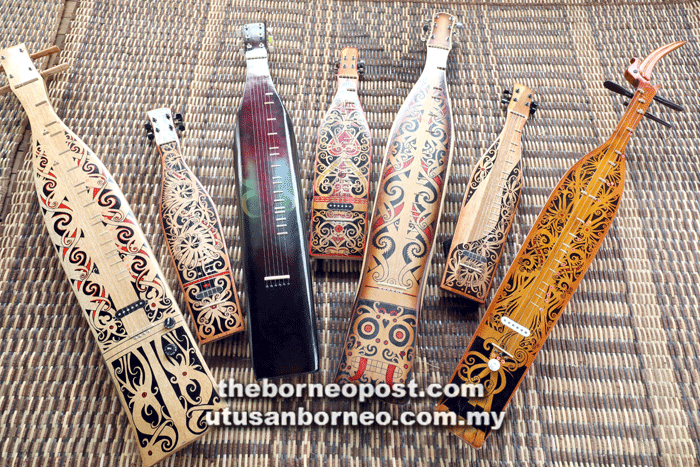
Dines shows the sape he is making at his house.
PASSION and patience are needed to make a sape – the traditional musical instrument of the Orang Ulu, particularly the Kayan and Kenyah, according to sape maker Dines Ngau Wan.

Dines shows the sape he is making at his house.
The boat-shaped string instrument is not complete without a traditional Dayak motif on it. Almost similar to a guitar, the modern sape also comes with strings, frets, a machine head, and electric pickup.
Dines, who is from Uma Bawang Baram but lives in Kuching as a primary school teacher, first dabbled in making sape in 2008.
“What motivated me was that back then, it was difficult to find this instrument for myself, friends, and those who liked to own one.
“The sape was not commercialised at the time. Most made it for their own use and were often reluctant to part with it,” he recalled.
He explained the sape can be made using conventional tools and wood from jelutong, gerunggang, pelaie, cempedak, and kayu adau.
“It’s the design and colour that attract youths to buy the instrument. Traditional sape used to be big – the bigger, the louder – but the sound is always soulful,” noted Dines, who was inspired to pursue his craft by sape maker Henry Anyi Ajang.

Anderson (right) conducts a workshop at the 11 Ridgeway Exhibition Centre.
Dines pointed out that the modern sape would only be practical if it were the size of an ordinary guitar because it had to fit into a guitar case for it to be conveniently carried around.
Initially, he carved sape from wooden blocks at the side and back of his corner terraced house at Taman Sentosa, Jalan Penrissen Lama in Kuching. But as the debris started piling up, he had to move to a spot near a monsoon drain just across the road where he set up a makeshift workshop.
He hired a few assistants to help him fill orders for the instrument from tourists, enthusiasts, and friends.
One of his challenges is looking for villagers to supply him the wooden blocks.
Each block costs around RM30, depending on demand and the type of wood.
On top of that, he has to be out of pocket when travelling to source for the wooden blocks.

Sape with various designs and motifs on display at the 11 Ridgeway Exhibition Centre. — Photos by Chimon Upon
According to Dines, the price of a sape is not much affected by demand and supply as the market is still very small – with prices fluctuating between RM450 and RM3,000, depending on size and design.
He said with ample time, tools and accessories, he could make a sape in a week.
International fame
The sape is already well known throughout the world – thanks to musicians such as Jerry
Kamit and Saufi Aiman Yahya, as well as annual international events like the Rainforest World Music Festival, among others.
Jerry, a Sarawak Cultural Village staff member since 1996, was part of the Malaysian team at the World Championship of Performing Arts in the US in 2009, while Saufi won gold medals at the same competition in 2017.
Many others have been instrumental in promoting and popularising sape music.
Dines said among those he could remember are Brandon Daby, Danison Manium, Howard Deri, At Adau Band Hayree Hashim, Hallan Hashim, Justine Jarop, Alan Alexandra, Julien Cottet, Matthew Ngau, Desmond Emang, Jimpau Balan, Elizabeth Bngan, Aaron Alan, Hazekiah Asim, Garry Sudom, Stephen Uloi, Lian Seling, Solomon Gau, Mat Linggi, Korintus Leban, Vyner Anderson, and Anderson Kalang.
Some of them are also sape makers.
Dines, who has a fond wish to see sape and sape music preserved for posterity, proposed setting up a single sape club in Sarawak and called on the relevant NGOs to play their part.
He said this is important to ensure the survival of the sape and its rainforest sound, which is synonymous with Sarawak.
Sape folklore
According to legend, the sape came about through a dream of a Kenyah man, who went into the forests to look for medicinal herbs for his sick wife after several shamans failed to cure her.
While taking a rest under a tree, he dozed off and, as the story goes, fell into a deep slumber and dreamt of his ancestors telling him his wife was in the spirit world and he needed to ferry her back to the real world.
So he carved a wooden block into the shape of a boat – to symbolise the transportation needed to save his wife.
After stringing the boat-shaped contraption with roots and leaves, he played a tune, complete with a chant, to pave the way for his wife’s return to the human world. The man later became a shaman.
According to sape music instructor Anderson Kalang, sape in his language of Kenyah means ‘to tap’ and the legend is some sort of love story.
“It’s about a man, who wanted his wife back after she was taken away. The instrument and music, therefore, have spiritual elements and to some, they can be used to cure illnesses.”
Anderson said beginners must learn to play or strum the basic melody of the ‘Datun Julud’ first to get a feel of the instrument and the music it creates.
